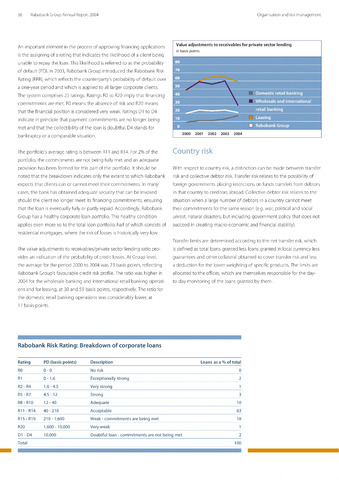Country risk
Rabobank Risk Rating: Breakdown of corporate loans
56 Rabobank Group Annual Report 2004
Organisation and risk management
An important element in the process of approving financing applications
is the assigning of a rating that indicates the likelihood of a client being
unable to repay the loan. This likelihood is referred to as the probability
of default (PD). In 2003, Rabobank Group introduced the Rabobank Risk
Rating (RRR), which reflects the counterparty's probability of default over
a one-year period and which is applied to all larger corporate clients.
The system comprises 25 ratings. Ratings R0 to R20 imply that financing
commitments are met. R0 means the absence of risk and R20 means
that the financial position is considered very weak. Ratings D1 to D4
indicate in principle that payment commitments are no longer being
met and that the collectibility of the loan is doubtful. D4 stands for
bankruptcy or a comparable situation.
The portfolio's average rating is between R11 and R14. For 2% of the
portfolio, the commitments are not being fully met and an adequate
provision has been formed for this part of the portfolio. It should be
noted that the breakdown indicates only the extent to which Rabobank
expects that clients can or cannot meet their commitments. In many
cases, the bank has obtained adequate security that can be invoked
should the client no longer meet its financing commitments, ensuring
that the loan is eventually fully or partly repaid. Accordingly, Rabobank
Group has a healthy corporate loan portfolio. This healthy condition
applies even more so to the total loan portfolio, half of which consists of
residential mortgages, where the risk of losses is historically very low.
The value adjustments to receivables/private sector lending ratio pro
vides an indication of the probability of credit losses. At Group level,
the average for the period 2000 to 2004 was 23 basis points, reflecting
Rabobank Group's favourable credit risk profile. The ratio was higher in
2004 for the wholesale banking and international retail banking operati
ons and for leasing, at 30 and 59 basis points, respectively. The ratio for
the domestic retail banking operations was considerably lower, at
17 basis points.
Value adjustments to receivables for private sector lending
in basis points
80
70
60
50
40
Domestic retail banking
30
Wholesale and international
retail banking
10
Leasing
0
HI Rabobank Group
2000 2001
2002 2003 2004
With respect to country risk, a distinction can be made between transfer
risk and collective debtor risk. Transfer risk relates to the possibility of
foreign governments placing restrictions on funds transfers from debtors
in that country to creditors abroad. Collective debtor risk relates to the
situation when a large number of debtors in a country cannot meet
their commitments for the same reason (e.g. war, political and social
unrest, natural disasters, but including government policy that does not
succeed in creating macro-economic and financial stability).
Transfer limits are determined according to the net transfer risk, which
is defined as total loans granted less loans granted in local currency less
guarantees and other collateral obtained to cover transfer risk and less
a deduction for the lower weighting of specific products. The limits are
allocated to the offices, which are themselves responsible for the day-
to-day monitoring of the loans granted by them.
Rating
PD (basis points)
Description
Loans as a of total
R0
0-0
No risk
0
R1
0-1.6
Exceptionally strong
2
R2-R4
1.6-4.5
Very strong
1
R5-R7
4.5-12
Strong
3
R8- R10
12-40
Adequate
10
R11 -R14
40-210
Acceptable
63
R15-R19
210-1,600
Weak - commitments are being met
18
R20
1,600- 10,000
Very weak
1
D1 -D4
10,000
Doubtful loan - commitments are not being met
2
Total
100

